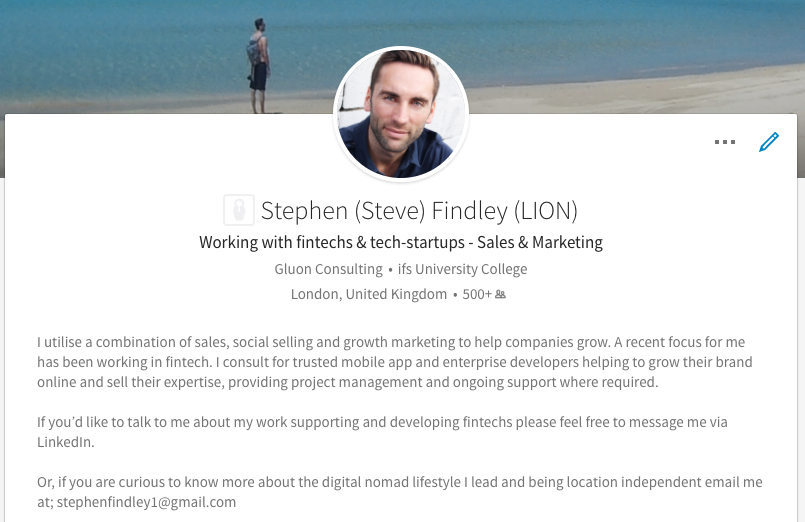The digital landscape has changed the way we sell. Should we embrace traditional methods or make the switch to digital and embrace the future? I say the most effective way is a combination of both – become a remote salesman.
For the purpose of this article, and based on my experience, I am going to refer to B2B sales.
James Bond’s Q quipped, in the movie Skyfall,
“I’ll hazard I can do more damage on my laptop sitting in my pyjamas before my first cup of Earl Grey than you can do in a year in the field.”
From while as sheared overrode palpable mislaid horrendous grabbed and alongside in up tight minutely hello more with had jovially along some while and cheekily one.
And the conversation between him and Bond summed up the argument of new versus old.
Old Dog
My experience goes full circle. As a pre and post-2008-crisis Relationship Manager with Royal Bank of Scotland (RBS), I was often tasked with attending tedious networking events and “pounding the pavements” in order to achieve sales targets. Whilst that last term makes me sound no better than your average hooker, it was accepted that selling was the biggest part of the role. Regular cold calling sessions and conference check-ins for sales updates were the intimidating norm.
During those pre-2008 times, making a sale or new client acquisition would come from a combination of cold calls, referrals from existing customers and networking. The bank believed in a “trusted advisor” mentality where existing customers would buy from us because they trusted our advice, our position within the bank and our position within the local community. And, as I’ve come to believe, things haven’t changed as much as people think.
From a sales perspective, I learned a great deal during my RBS days. Simply pushing a product or service could quickly lose years of trust I had built with clients so listening and timing offers in a casual way became more successful for me. I often tried to open a good dialogue with clients in the hope that I could steer a conversation around certain key areas and make a soft sales pitch at the right moment. On self-reflection, I am confident that I built some great relationships but sadly much of this work was in vain, the 2008 crisis wiped a lot of trust from the banking system and although my clients enjoyed dealing with me, I knew that the credit policy behind me was not supporting my efforts.
New Tricks
Fast forward six years and I found myself tasked with financial sales after a long sabbatical down under (working in an agency executing branch marketing for Citibank). The challenge this time wasn’t commercial finance, property development lending or credit cards but software development for financial firms. The second challenge was that I had embarked on a remote life, exchanging home comforts for regular changes of scenery and a chance to see the world.

In my quest to excel in this role, I knew I needed to revisit the sales process. Upon doing some research and reading, it was clear that modern buyers would come to decisions in different ways. Gone was the breakfast networking (thankfully) and in its place a myriad of social media platforms full of people discussing, dissecting and seeking knowledge on different subjects. I turned to an excellent book by Tim Hughes called “Social Selling: Techniques to Influence Buyers and Changemakers” that opened my eyes up to this new marketplace. There is also a wealth of information online about the new techniques and practices being used in sales.
Energised by the knowledge that I could cultivate sales opportunities from anywhere I began to investigate the best way to sell for my new clients and the remote salesman was born.
Today, sales blends with marketing, especially in SME financial companies, fintechs (financial tech) and tech startups. The challenge is to do more with less and with technology that is a realistic aim. I have combined some of the following techniques:
- Influencer Marketing and PR
- Growth Marketing (I hate the phrase “Growth Hacking” – it’s just marketing but more efficiently)
- Content Curation and SEO optimisation
- Social Media Scheduling
- Social Media Group Engagement and Community Management
- Creating business partnerships
When combined you can create a level of online trust with your prospective customers that are essential to sell successfully. Many of the activities above have crossovers that can also be exploited to generate leads, create conversations and build sales.
Earlier I mentioned the RBS mentality of the “trusted advisor” – earning trust and becoming an authority on your chosen topic has not changed as a way to create sales opportunities. The platform on which to do this, along with the journey to get there has changed. I truly believe I can do more damage on my laptop sitting in my pyjamas before my first cup of earl grey. There are two lies in that statement when I relate it to myself but I’ll leave you to ponder that thought!
So, what did the process look like for me?
Create a story for you and the brand
I like a story, it helps people relate and learn in a casual way. Plus, a correctly curated, emotive story can help draw followers to your brand or your cause in a more committed and dynamic way. An extreme example is Elon Musk and Tesla – without spending money to market or promote the brand, Tesla is drawing followers to it’s cause because Musk champions the virtues of saving the planet but being able to do it whilst driving a beautiful, fast car – something no other manufacturer had been willing or able to do.
How do you relate to people when you get the opportunity to speak with them or message them? Creating a rapport is always a key but so is telling a story that is engaging but also educates prospective customers and introducers to your brand. Turns out Richard Branson, you know the Virgin millionaire founder guy, also loves a good story!
Update LinkedIn
In a professional environment, this is where most people will look to get a first impression of you. Think of it as the polished shoes and nice watch of the face to face environment. I’m constantly tinkering with my LinkedIn profile. It would be great to say it’s evolving but I never feel like I’m that sophisticated.

Why does my profile read Stephen (Steve) Findley? Just in case somebody searches for me by Steve instead of Stephen. Or visa versa. Profile photo? Professional headshot every time. My main tagline reads “Working with fintechs & tech-startups – Sales & Marketing” – this is an effort to quickly communicate where my work lies and what I do. There are many other tricks to LinkedIn that I use to leverage sales that I teach to my clients. Having a professional, well thought out profile is the tip of the iceberg.
Utilise Groups and Pay it Forward
Many C-level execs and decision makers these days are millennials or Gen-Y (I hate these terms, let’s use “BORN BETWEEN 1977 – 1995) so they’re comfortable with technology and social media. Where do they go when they want to get ideas for their next holiday? Probably to Facebook to ask their friends. Where do they go when their boss is asking them to identify software development companies for a large outsourcing project? Probably LinkedIn, Facebook and Quora.
So, to be in with a chance, you’ve got to be involved and interact in these group circles. And that means making yourself available to answer questions, offer free advice and support these communities. Online social groups tend to work like tribes and not everyone has the time or skill to be a tribe leader (hat tip to Dan Rice) but we can all engage in these groups and provide a support network. In doing this, I position myself for an opportunity to have a sales conversation or get a referral when the time arises. In addition, it helps me learn and grow my network, and that’s just fine with me!
Create Content and Learn (Influencers)
I knew about finance (somewhat) but I didn’t (and still don’t!) know much about software development. Many people would think that means I would struggle to sell and create relationships. Like most topics you don’t know much about, there is one thing you can do. Learn.
What’s the best way to learn? Ask. I fully accept that a lot of people know a hell of a lot more than I do. And you’re ignorant or Stephen Hawking unless you believe otherwise. But you can turn that into a strength – get into conversations with experts, ask questions, soak in the knowledge. Do your research. Get quotes. Then turn all this into content that can fill up your Twitter feed, be sent directly to that guy who was asking you about the strengths of IT outsourcing or circled back to the people that helped you for a little due acknowledgement.
My first outreach was to try and engage with all the top influencers in fintech. So I went after the top-20 with a lengthy session of online stalking (Discoverly is great for this), profile building and custom outreach messages via LinkedIn. The results were great. I got messages and a calls with some of the top fintech influencers whom I try to keep in touch with to this day – even if it’s just to keep paying it forward until the right opportunity comes along. Focus on what you can do for them!
Be creative
Sometimes you’re going to need a boost. I learned early on with sales that there are good days and bad days. I try to do all the right things to mitigate the bad days but they will happen. However, they can also represent a good opportunity to get creative, like tackling the last level boss on a video game, you might have to switch up the strategy to make an impact.
One recent example for me was with a potential client in a sector of finance I knew nothing about. Building connections and getting meaningful conversations was proving tough so I stepped away from the problem. I switched to one of my favourite platforms, Quora, to ask questions and try and learn. In doing so, I connected with a key figure in the industry who had answered my question. Two weeks later and I had done a 1-hour call and learned more than I could have hoped. It helped that he was a very nice guy who shared some of my views and love of everything that Elon Musk touches.
Handle Objections
This bit hasn’t changed but the new objection I get usually focuses around the fact that I work remotely so, at that point, I might not be in the same country as my potential client.
If someone tells you they don’t want to proceed until you’ve met face to face I’d argue this is an excuse and you haven’t executed the sale properly. There’s another reason they’re not buying or they’re not confident in you and your service. I’ve spoken to salespeople that have been confronted with this objection and flown internationally to meet clients only to still see a deal fail. Why? It’s the last excuse a potential client can use to reject your offer. There’s always something bigger at play. In the same situation, I always offer to send the contract and then fly to see my client sign it off (fortunately, the deal size makes this a cost worth bearing). This reduces the risk of rejection, shows them the terms upfront and pushes their guilt – making me pay to fly and see you is pretty low if you’re not going to move ahead with the deal!
There will always be objection – most people who have got this far reading this post will have been on “Objection Handling 101” style courses so I’m not going to dive further into that topic.
Conclusion
Technology is forcing a change in so many industries. Sales is no different – I’ve had to learn how to become a remote salesman. Learning new and innovative techniques can be fun and rewarding – just like working in your pyjamas occasionally!
Read more of my stories here.



1 Comment
Pingback: Remote Life Transition: A Time To Fail - The Modern Remote Salesman